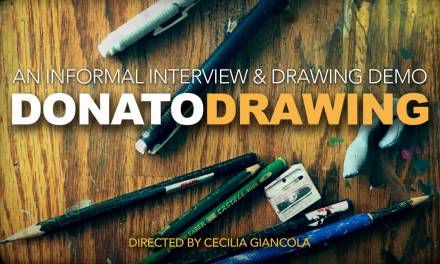By Lauren Panepinto
Note: This post is a bit out of the ordinary, in that it’s more of a tool than an article. If you’re a professional artist or art director, chances are you’ve gotten anywhere from a trickle to a Noah’s Flood of student interview requests, because I’ve been seeing more and more professionals bemoaning them online. It feels like every teacher at every art school last year must have given out the “Interview a Working Professional” assignment because I’ve been getting at least 2-3 a week all 2016. Are there seriously that many art classes? I bless those professors I know who refuse to give this assignment—mostly because they are also working professionals and know how time-consuming and frustrating they can be. Here’s a page to direct students to, when these requests come in. Or feel free to do some copying-and-pasting for yourself. Here goes…
Dear Student Who Just Sent Me This Long Email of Questions Copied and Pasted from the Assignment Your Teacher Gave You:
Hi. I know you’re just trying to do your homework, but let’s make this more rewarding for you (and more interesting for me). Let’s turn this into a real-world exercise. If you’ve chosen me as the subject of this assignment, it must mean it’s because I am doing a job you’d like to do some day. So let’s imagine you in my shoes. You’re successful at this (freelance illustrator, art director, designer, concept artist, other) job so that means you’re extremely busy doing the job you are dreaming of. That’s awesome, but it’s also a ton of work. Dream jobs are great, but they have a pesky way of being tremendously time-consuming. Trust me.
So you’re drawing……say a new creature for the next Star Wars movie……and your inbox dings. It’s a quick intro by a student followed by a mostly cut-and-pasted list of very clichéd questions. How did you get into art? What’s the most interesting part of your job? What’s your favorite project? Etc. You feel a pang of guilt but you’ve already gotten 2 emails from students this week (it’s final project time of semester) and you don’t have time to write out answers. And the student didn’t even bother to google your very findable interviews already in print where you’ve answered these questions 20 times. And it’s pretty obvious they didn’t think about personalizing the questions at all. Oh well. One of these days you’ll get around to putting a FAQ on your website to direct students to, but you’re too busy with the above-mentioned creature gig. Deadlines come first. Delete email.
Students, you can see where I’m coming from, right? It’s not that I don’t want to help out a student, but I already travel all over the country to conventions and do a ton of portfolio reviews, as well as teach classes, guest lecture in other people’s classes, write educational blog columns, and I’m always happy to talk to any students or recent grads at professional events. I just don’t have time to type out my answers long-form to one person at a time.
So homework isn’t optional right, so how do you do it AND optimize the likelihood of that pro writing you back? Here’s a few tips:
—Start off your email with “I know you get a thousand of these requests” and “I want to make this as easy as possible for you” and “I’ve already done research on you online”— show you understand that a professional would be taking time out of their busy schedule for you and that you’ve already done your homework ON them.
—Actually research their website and press first. (Including podcasts!) You’ll probably be able to cut and paste quotes straight from previous sources (remember to attribute your sources, don’t worry your teachers will be impressed). Then come up with new questions that haven’t been asked before. Extra credit if the questions have something unique to do with the artist or are directly inspired by the artist’s work.
—Offer to do a phone call and record the call to transcribe rather than ask someone to write essays for you. It’s true, most of us do our work 99.9% by email, but in this one case, it’s much faster and easier on the professional if they can just talk to you rather than compose their answers in writing. Record them like a real journalist! Again, your teacher will be impressed.
—Expect that most artists will not be able to get back to you in a short amount of time (if at all) so give them as much time to reply as humanly possible. If they don’t get back to you, move on to someone else, don’t pester them.
—Remember, the more well-known the person you are contacting, the more requests like these they get, so more local/smaller following artists are better here. Remember, you can sometimes apply a lot more advice from someone a few steps up the ladder from you rather than someone light years ahead.
—Be polite, and thank them! There’s nothing worse than taking time out of your schedule to help someone out then having them act like you owed it to them just because they’re a student.
—Feel free to direct your teacher to this post (see below)
Dear Teacher Who Assigned the Contact-A-Working-Professional Project:
Hello. I appreciate what you’re trying to do here. Talking to real live professionals is a critical step in any student’s education (not just future artists). I’ve written tons of posts on the importance of
networking.
(Also, I’m a teacher, and coming up with great assignments is really hard, so I sympathize.) However, you know what would be really rewarding to your students? Making this assignment as real-world as possible. In the professional world, people are busy and students need to get hammered into them that no one owes them anything. This project isn’t about getting your questions answered, it’s really about how to get someone who has work (Art Directors, Gallery Owners, Clients, Agents, etc.) to pay attention to you and remember you. Two things impress people higher up the chain, no matter what chain it is: Research and
Empathy.
Research: Don’t give your students a list of questions to copy and paste
(I know, you didn’t intend them to cut and paste the questions, they were meant as inspiration, but let’s be real here, they’re cutting and pasting them into emails). In fact, make a list of questions they’re NOT allowed to ask. The basic questions should be answered by internet research only. Teach them the magic of
Google-Fu. It’s the skill that will get them the furthest in their careers. Then, after researching their
victim subject, they should come up with new questions that are inspired by and unique to the subject and their work. Part of their grade should be coming up with great questions.
Empathy: Teach your students to imagine themselves in the shoes of the person they’re trying to contact and think about what would make them most likely to answer. This is a critical skill for having great relationships with clients and ADs and editors. An artist who thinks about my problems (not just their own) is worth their weight in adamantium. It’s not just about impressing the person you’re in contact with, but also making it easy for them to turn around and get an easy green-light from their approvers. That’s all empathy, and it can start with this assignment. They need to be polite, gracious, and most of all make getting their answers as little of a burden on the professional as possible (see above section to students).
Thanks for listening, and have a great semester!
P.S. if you want to see what working professional really think about these assignments, check out my Facebook post on it which led to this article. Great food for thought. Pros really do want to help students (many of us are teachers too, so we want to help educators as well) but the way these assignments are aimed (and the entitlement that often comes along with the request) is the problem.
P.P.S. yes, I know I just wrote a blog post aimed at kids born in the 90s, so they’re not going to get the gif references. LET ME HAVE MY FUN.










I´ve received dozens of these e-mails in the last couple of years, and I´m barely known, so I can´t imagine how many of them do you and the guys on this blog get. I try to answer them when I have time (with the extra complication that I´m not an English speaker so it takes me even more time to answer all those questions). But what annoys me the most is that practically none of them send a simple “thanks for your time” after I reply.
SO GOOD. This is the silent plague for many of us. I think this idea is great as far as ideas go, but how they get implemented and how they are delivered is rarely a good thing. Thank you for writing this. Thank you Green Friend.
When I first started to get interview requests, I would generally help the student out if I had time in my schedule. However, just like Diego's comment, many did not even have the decency to give a simple thank you! Therefore a few bad apples soured me to doing any more. In a way, granting these student interviews is like doing spec work… you are giving away your time for free. My suggestion to any students attempting this is to research the artist you are contacting and show some sincere personal interest in their work. You might get results that way.
Brilliant!
You're welcome, Crazyballs.
oh come on, you don't think 90s kids have seen the breakfast club?
Great read, brought back vivid memories of when I had to do this same project a decade back. I was so embarrassed at the thought of pestering a professional that I made up a fake person and answered my own questions.
I'm going to start linking to this article every time I get one of these… which should probably be tomorrow.
Ditto!
I would have given you an A+ for creative problem solving, lol
exactly my intention! enjoy!
Lauren,
This was such a great article. Thank you for writing it. It amazes me how many students think NOTHING of asking an artist to take several hours to answer thirty or so insipid questions.
Pfft kids born in the 90s know what “The Breakfast Club” and “Ferris Bueller's Day Off” are.